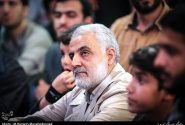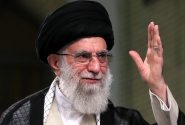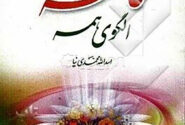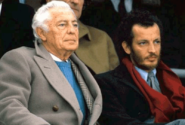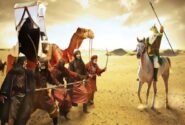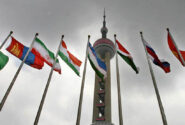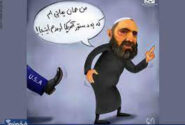The Hashashin Sect is considered the first group of professional killers in history, who during their activity in the 12th century were able to assassinate important figures such as Khwaja Nizam al-Mulk.
For almost two centuries from 1090 to 1273 AD, the Hashashins played a very important and decisive role in the Middle East. They were a small group scattered in different regions of Iran and Syria. Due to their small number, the Hashashins did not have the ability to face the armies of their time, but nevertheless, at the end of the 11th century, Hasan Sabah, the founder of the Hashashins, was able to form one of the deadliest terrorist groups in the world.
The Hashashins were the most feared group in their time, so that even the most powerful kings and rulers of that time, namely the Abbasid and Fatimid caliphs, the Seljuq and Ayyubid emperors, the princes of the Crusader states and the emirs who ruled cities such as Damascus, Hams and Mosul, were afraid of them. During their career, they were able to kill two caliphs and many ministers and sultans, as well as the leaders of the crusades.
Most of the time, the members of the Hashashin sect used to monitor their enemies for months or years and tried to get close to them so that they could finally put a dagger in their heart. The agents of this group mostly considered public places to kill their targets in order to have the greatest impact on the enemies and people of their time. Today, after 750 years have passed since the destruction of Hashashin by the Mongols, the tactics and activities of terrorist groups such as Al-Qaeda and the Taliban have similarities with Hashashin.
But at that time, Hassan Sabah considered the terrorist acts against senior military, political and religious members not as an aggressive act but as a defense of his people against their positions and attacks against the Nizari Ismailis. In any case, there is no doubt that Hashashin’s activities had a great impact on the policies and military movements of the Middle East at that time.
Who were the Hashashins?
In the following, we provide information about the Hashashin group.
Hashashin’s name
There are many differences regarding the origin and meaning of Hashashin. For the first time, the followers of the Mustaliyah branch, who were rivals of the Nazarites, chose the name Hashashin for this group during the fall of the Fatimid caliphate. Contrary to popular belief and some experts, Hashashin does not mean those who smoked hashish and then committed acts such as murder, but this name is derived from the term hashish, which itself is derived from the word hashish, which means pharmacist (botanists). In the 4th and 5th solar centuries in Islamic countries, especially in Iran, drug sellers were called Hashashin, and in some big cities of Iran, there was a market called Hashashin (drug sellers) market.
Some like the Lebanese writer Amin Maalouf and the English writer Edward Burman believe that the founder of Hashashin, Hassan Sabah, chose the name Asision, which means those who follow and adhere to the principles, for his group, and foreign travelers like Marco Polo mistakenly thought that this was the case. The name is derived from the word hashish. They believe that since the use of hashish is forbidden in Islam, the enemies of this group deliberately spread the name Hashashin, which means those who smoke hashish, to describe them in order to destroy and discredit them.
Hashashin’s beliefs
The Hashashins were followers of the Ismaili religion. This religion emerged in the 8th century and its followers consider Ismail, the son of Imam Jafar Sadiq, as the last Imam of Islam. For this reason, they are also called Haft Imami Shiites. At the end of the 11th century, after differences arose over the caliphate of Nizar and Mustali, the Ismailis themselves were divided into two branches.
Those Ismailis who believed that Nizar should be the next caliph formed the Nizari branch and those who believed that Mustali should be the caliph formed the Mustali branch. The followers of Nazariyeh had more military activities than the other branch, and they were the ones who were later known as the Hashashin sect.
The realm of government
Originally led by a missionary named Hassan Ibn Sabah, the Nazarites settled in Iran and formed a new religious political group similar to the Knights Templar in Europe. After education and training, the members of the group were placed in different grades and rankings depending on their knowledge, reputation and courage. All members without exception obeyed the group leader’s orders and were loyal to him.
With the passage of time, the number of members of the group increased and their power increased to the point where they were able to conquer several mountain forts. Most of the bases of this sect were located in northern Syria. They also shared a border with some of the Crusader governments. Perhaps the most important part under the control of this group was the city of Masyaf, which was captured by them in 1141 AD. This city and its castle played the role of Hashashin capital in Syria.
After the defeat of the Europeans in the Second Crusade and their inability to occupy the city of Roha, as well as the destruction of the two armies under the command of Konrad III, King of Germany and Louis VII, King of France, the followers of Nazariyeh were able to continue their domination without a rival and increase their power. In addition, from time to time, by paying tribute to the crusader governments or supporting them against the Sunni Muslims of the region, they were able to avoid attacks and continue their lives in isolation.
In the 13th century, the population of this sect increased more than ever before, and its followers were present in Egypt, Syria, Yemen, southern Iraq, southwestern Iran (Khuzestan), and Afghanistan. Although they were mostly isolated from their enemies and even each other, at least they lived in peace and security in their impenetrable fortresses. However, word of their existence eventually spread, and their cult leader became known in the West as the Old Man of the Mountain by the Europeans involved in the Crusades. At that time, this title was given to Rashid al-Din Sinan, who was the leader of the Nazarite religion in Syria during the Crusades.
One of the most important bases of the Hashashin sect of Alamut was Mimun Dej and Alamut Castle in the south of the Caspian Sea. There is no information about the current location of Mimun Dej, but Alamut Castle is still standing. This castle, which was one of the first castles that came under Hashashin’s rule in 1090, was the main headquarters of this group in Iran and also the residence of the leader of the Hashashin sect. This castle is built at an altitude of 2163 meters above sea level on steep cliffs and deep cliffs and is not easily accessible. Hashashin Alamut Castle, like other Hashashin castles, was made of stone foundations and wooden buildings. Another important castle that we can mention is Masaif Castle in Syria, which is made of several layers of walls and is a concentric castle.
The goals of the Hashashin sect
One of the most famous victims of Hashashin was Khwaja Nizam al-Mulk Tusi, the powerful vizier of two Seljuk kings, who was murdered on October 14, 1092. Another victim of this group, who was ironically the first Christian to be assassinated by the Hashashins, was Raymond II, Count of Tripoli. In 1152 AD, he provided a land near the Hashashin base in Syria to hospitable knights. After his death, the authorities carried out a large-scale massacre of the people in the area to find the killers, but in the end they could not find the perpetrators of Raymond II’s assassination.
The third famous victim of Hashashin was Konrad Montferrat, who was killed on April 28, 1192. Conrad, who had been elected as the king of Jerusalem just a few days before his death, was stabbed to death by two teams of assassins one night in the city of Tyre, returning home from a party. Assassins dressed as monks were able to approach Conrad on the pretext of showing him a letter and then attacked him. After his death, Richard I, also known as Richard the Lionheart, was accused of Conrad’s murder. Since the Third Crusade was still going on without any significant success for the Westerners at the time, they had a lot of disagreements among themselves about who should dominate what parts of the Middle East, and so many were of the opinion that that Richard ordered the murder of Konrad to Hashashin.
Of course, sometimes the murders were so effective and successful that no one was sure that it was Hashashin’s work. The murder of Modoud Atabak of Mosul is one of these cases. He was attacked on October 2, 1113 when he was returning home from the Umayyad Mosque in Damascus. The killer approached him on the pretext of taking charity and then took his belt and stabbed him twice in the stomach with a knife, but he could not escape. After his arrest, he was executed and his body was burned. But at that time, no one was sure that he was sent by the Nazarites or the Hashashin sect. For this reason, it is not clear whether they were responsible for several mysterious murders at that time or, on the contrary, several murders were wrongly attributed to them.
The following table shows the assassinations attributed to Hashashin:
| the victim | History | place |
|---|---|---|
| Khwaja Nizamul Molk Tusi | October 14, 1092 | Nahavand, Borujerd |
| Jinnah al-Dawla, Amir of Homs | May 1103 | Homs Grand Mosque |
| Khalaf bin Malaab, Amir Afamiya | February 3, 1106 | Afamiya (Syria) |
| Maudod bin Altuntkin, Atabek of Mosul | ۱۱۱۳ | Damascus |
| Amir bin Mustali, the Fatimid caliph | ۱۱۳۰ | Cairo |
| Taj Al-Maluk Buri, Atabak of Damascus | May 7, 1131 | Damascus |
| Al-Mustarashad, Caliph Abbasi | ۱۱۳۵ | near Hamadan |
| Rashid Balleh, Khalifa Abbasi | ۱۱۳۸ | Mosul or Isfahan |
| Raymond II, Count of Tripoli | ۱۱۵۲ | The gate of the city of Tripoli |
| Conrad I, King of Jerusalem | April 28, 1192 | Acre |
| Moezuddin Mohammad Ghori, Sultan of Ghoriyan | March 15, 1206 | Near Suhawa in Pakistan |
| Raymond son of Bohemond IV of Antioch | ۱۲۱۳ | Tartus, Syria |
| Philippe Montfort, Lord of Tyre | March 17, 1270 | Tire, Lebanon |
One of the targets who managed to survive was Salah al-Din Ayyubi. Saladin, who was a Sunni Muslim, became one of the Hashashin’s targets after he announced that he would crucify all apostate Muslims. They answered Saladin in their own successful way; That too twice. But they were unsuccessful in assassinating him both times. The first time in 1175, a group of 13 assassins could not get close to him, and the second time in 1176, four assassins who were responsible for killing Saladin could only tear off his armor and one of his cheeks before being slaughtered by his bodyguards.
Saladin, on the other hand, decided to respond with force to these attacks and attacked the city of Masyaf and its castle for a week. But then it strangely retreated. It is said that the reason for this was that Hashashin entered his tent in the middle of the night, but instead of killing him, they put a knife under his pillow as a warning. They had previously threatened Nuruddin Zangi, the ruler of Aleppo and Raha, in the same way. But according to another version of this story obtained from Ismaili texts, Hashashin put a poisoned cake with a note that said “You are under our dominion” under his pillow.
All these narrations point out that if a person was included in Hashashin’s assassination list, he could not easily survive. Salah al-Din also seemed to understand this, and for this reason, after meeting with the leader of the Syrian Hashashin sect, he signed a non-aggression pact with them. However, he was still not relieved, and after that, instead of sleeping in a tent, he slept in a wooden tower and stopped meeting people he did not know.
Finally Hashashin
Manguqa’an Khaqan chose the Mongol rule of his younger brother Hulaku Khan to attack Iran. After occupying Iran, he defeated Hashashin castles including Alamut in 1256. Hashashin had become one of their targets when they attacked Iran due to the fact that they had previously killed Giuk Khan, one of the top commanders of the Mongols during the time of the previous Khaqan. In addition, it is said that Hashashin tried to kill Manguqaan as well, but they did not succeed.
The Mongols managed to occupy the forts thanks to their advanced military equipment, including incendiary catapults that could target targets from a long distance with great precision and power. In order to be able to attack the fortresses of the Hashashin sect, which were located at a very high altitude, they carried the catapults in smaller pieces to higher altitudes and reassembled them there.
Of course, the Hashashins did not hide behind the walls and defended themselves with their own catapults as well as bows and arrows and were able to inflict many casualties on the Hulako Corps. But in the end, after the capture of the Hashashin leader, Ruknuddin Khorshah, everything ended. The remaining Hashashin in the castles, including women and children, were massacred, and those who survived were captured and enslaved. After the fall of Hashashin, the generation of Nazarites living in Iran was completely destroyed. However, several castles remained standing in Syria, but they were also destroyed after the attack of Bahri Mamluk sultan Baybars. Until 1270, many of Hashashin’s fortifications and castles were captured by the Bahri Mamluks.
After the Mongols decided to attack Baghdad, other Muslims looted those Hashashin libraries that had not been destroyed by the Mongols, including the famous library of Alamut Castle, and saved several Hashashin books that were of great value. Most of these texts are now in Maragheh. Of course, they also burned all the texts related to the beliefs of the Ismailis.
The best video games related to Hashashin cult
Hashashin were a part of European and Western culture from the Middle Ages until today. The word Assassin was introduced into the English language by Europeans during the Crusades and has been used ever since to describe a professional assassin or the sudden killing of a well-known figure. In addition to these films, series and video games, many references have been made to this group. For example, it is said that George R. R. Martin created The Faceless Men in the novel A Song of Ice and Fire, inspired by Hashashin. But perhaps the clearest reference to this group has been made in several video games, of which we will mention a few examples below.
The Exile game series is about a Hashashin member in Syria who can travel through time to assassinate important religious, historical and modern figures. Of course, in the console and English versions, many references to today’s religious figures have been removed and these characters have been replaced by fictional characters. The series consisted of 4 games that were developed and released by Telenet Japan from 1988 to 1993.
Assassin’s Creed
The Assassin’s Creed series, which is considered one of the most popular and best-selling games of the past few years, was inspired by the Hashashin sect and is known as the main Hashashin game. Of course, the storyline of this series is completely fictional. In this game, Hashashin are not limited only to the Middle East and we see their presence in Europe and America as well. In this series, Hashashin and the Knights of the Temple are blood enemies of each other and both are shown as a philosophical and not a religious circle.
The Knights Templar and Hashashin in this series were formed in a very distant time, contrary to reality, and as a result, the main narrative of the story consists of events that are fictional and not real. In this series of Hashashin clothes, Hashashin weapons and also the Hashashin symbol are completely fictional and are far from reality.
Of course, a significant part of what happens in the game is rooted in reality. The creators of the game even used a quote that is said to be the last words of Hasashin founder Hassan Sabah in the game:
There is no truth and everything is allowed
Of course, there is not much documentation that can attribute this quote to Sabah. Since its inception in 2007, the Assassin’s Creed series has grown into a huge franchise that includes 23 games, as well as movies, comic books, and various novels.
Crusader Kings 2
In the Sword of Islam expansion pack of Crusader Kings 2, the Hashashins are introduced as a sacred sect related to Shia. Users who start the game as Shiite rulers can use Hashashin to fight against territories under the influence of non-Shiite rulers. In the expansion pack Monks and Mystic, Hashashin play a wider role as a special and mysterious guild.
Although the Nazarite’s military and offensive power declined and disappeared over time, they still live in nearly 25 different countries and comprise a population of over 15 million people. In the end, we must pay attention to the fact that most of the narratives that are narrated about Hashashin are made up by their enemies and are not true. But the influence that this small group had on the powerful kings and rulers of that time has been an inspiration to different groups even today.







